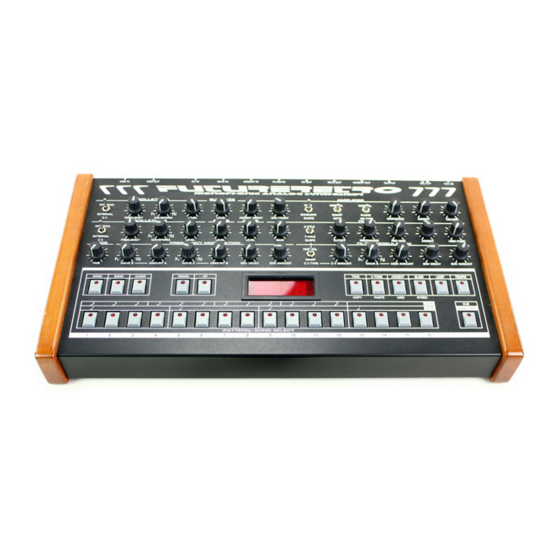
Table of Contents
Advertisement
Quick Links
Future Retro 777 Modifications
Most of the modifications explained here are simple to do if you have at least some
experience with soldering. If you are not sure you know what you are doing have
someone help who has some experience. If you are not clear on how to do some of the
modifications, contact us and we will do our best to help.
Increasing envelope range
Extended envelope range for filter cutoff
Solder a 220K resistor in parallel with R131 (220K) or replace R131 with a 100K
resistor, for twice the range.
Extended envelope range for OSC B
Solder a 47K resistor in parallel with R178 (47K) or replace R178 with a 22K resistor,
for twice the range.
Creating faster envelope rates
Snappy filter envelope
Short out R78 (47K) or replace R78 with a 50K potentiometer for adjustable accent times
and shortest possible envelope times for the filter's envelope. NOTE: You will probably
want to make this mod switchable between original and mod version. To do so use a
DPDP switch and use it to short resistor R78 or to switch between resistor R78 and the
50K potentiometer.
Faster envelope time for OSC B's sweep
Same procedure as the "snappy filter envelope" but with resistor R68 (47K).
Infinite VCA envelope time
Envelope drone for VCA
By lifting D11's (which will be either a diode or (zero) 0 ohm resistor, depending on
revision) lead that goes to ground and making this connection switchable you can cause
the VCA's envelope to sustain for an infinite amount of time. When D11 is disconnected
from ground, once triggered the envelope's capacitor will be unable to discharge keeping
the VCA level on. The VCA will stay on until D11 is connected back to ground or the
Gate is selected to control the VCA. Note: The envelope will need 1 trigger either from
the internal sequencer or from the external gate in to start the envelope. Once the
envelope has been started/triggered you can either play with the droning tones while the
sequencer is stopped or let the sequencer run and control everything as usual.
Advertisement
Table of Contents

Summary of Contents for future.retro 777
- Page 1 Future Retro 777 Modifications Most of the modifications explained here are simple to do if you have at least some experience with soldering. If you are not sure you know what you are doing have someone help who has some experience. If you are not clear on how to do some of the modifications, contact us and we will do our best to help.
- Page 2 Extending the range that accent will affect the filter’s cutoff frequency Filter accent amount You can change R130 (100K) anywhere from a 100K to 10K resistor to adjust the amount of affect accent will have on the filter’s cutoff frequency. The less resistance used the higher the cutoff frequency for accented notes will be.
- Page 3 Control voltages should run between 0 and +6v, avoid higher voltages than +6v or any negative voltages! NOTE: If you use a switching type jack you could wire the secondary CV input so that when nothing is plugged into it, it allows the original CV IN source to control oscillator B.
- Page 4 There are 3 analog switches that are not used. These are in IC U11, and U14 (part type 4066). These IC’s run between ground and +12v. Pins for unused switches are: 1) 1 & 2 are input/output, pin 13 is control 2) 10 &...
- Page 5 Additional information Filter cutoff frequency adjustment It is not recommended to adjust the internal trim pots in the 777, unless you are retuning the instrument. There is one trim pot users can adjust to their liking. It is to control the range the cutoff knob has on the filter’s cutoff frequency.
- Page 6 Sub oscillator waveform The waveform each sub oscillator produces is a square wave. By selecting a sawtooth waveform in an oscillator (oscillator A), with its level at max, you can then turn up its related sub oscillator level (sub- oscillator A) and the result waveform is a sawtooth 1 octave below the frequency of oscillator A.


Need help?
Do you have a question about the 777 and is the answer not in the manual?
Questions and answers